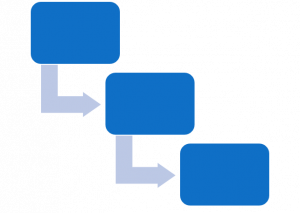Project management methodology (PMM): Difference between revisions
Cristelags (talk | contribs) No edit summary |
Cristelags (talk | contribs) No edit summary |
||
| Line 3: | Line 3: | ||
The following is an overview of a few different PMM that hopefully inspires curiosity to learn more. Please contribute additional PMM or other examples to the '''[[DLF Project Managers Toolkit]]'''. | The following is an overview of a few different PMM that hopefully inspires curiosity to learn more. Please contribute additional PMM or other examples to the '''[[DLF Project Managers Toolkit]]'''. | ||
[[File:Waterfall.png|thumb|right | [[File:Waterfall.png|thumb|right|Waterfall PMM]] | ||
waterfall (software development) | waterfall (software development) | ||
* detailed linear process of tasks in sequential order | * detailed linear process of tasks in sequential order | ||
| Line 11: | Line 11: | ||
* good for large projects with multiple stakeholders | * good for large projects with multiple stakeholders | ||
* not flexible, if assumptions are wrong, hard to pivot | * not flexible, if assumptions are wrong, hard to pivot | ||
critical path method (CPM) (industry) | critical path method (CPM) (industry) | ||
| Line 17: | Line 18: | ||
* not good if unsure of timelines, durations for tasks | * not good if unsure of timelines, durations for tasks | ||
* not flexible if there are major changes | * not flexible if there are major changes | ||
agile (software development) | agile (software development) | ||
Revision as of 12:39, 6 November 2021
Project management methodology (PMM) is a system of principles, techniques, and procedures.
The following is an overview of a few different PMM that hopefully inspires curiosity to learn more. Please contribute additional PMM or other examples to the DLF Project Managers Toolkit.

waterfall (software development)
- detailed linear process of tasks in sequential order
- project flows downward like waterfall
- comprehensive, predictable and planned out
- focus on documentation
- good for large projects with multiple stakeholders
- not flexible, if assumptions are wrong, hard to pivot
critical path method (CPM) (industry)
- identify and schedule tasks, duration and dependencies
- good for tight timelines and repetitive activities
- not good if unsure of timelines, durations for tasks
- not flexible if there are major changes
agile (software development)
- reaction to waterfall method http://agilemanifesto.org/
- "early and often, adjust and iterate"
- flexible and responsive to change
- stakeholders must stay engaged and be available to provide timely feedback
- not always fast in practice if constantly changing deliverables
- not focused on comprehensive documentation
There are many agile approaches including scrum, kanban, feature-driven development, and extreme programming.
scrum (software development)
- small, cross functional teams
- short sprints
- regular "stand-up" meeting
- retrospectives after each sprint
- focus on continual optimization and improvements
- harder to do with fixed budgets and timelines
- self-managing teams can have issues with scope creep
kanban (industry)
- billboard in Japanese
- simple, clear framework
- visualize workflow and tasks
- large and small teams, remote or in person
- not detailed "at-a-glance"
- not if complex, lots of steps in the process
hybrid/structured agile
- combine waterfall and agile methods
- focus on gathering and analyzing requirements then rapid iterations
- best of both worlds - structure and flexibility
- best for medium-sized project with high complexity and fixed budgets
Lean Six Sigma (industry)
- Define, Measure, Analyze, Improve, Control
- cut waste and maximize efficiency
- quality management, continuous improvement
- measuring > analyzing > improving
- large organizations or efficiency is an issue
Integrated Project Management (IPM)
- focus on documents like project charter, plan, execution, monitoring and change control
- meet regularly as team
- accountability
- time for planning
PRiSM Projects Integrating Sustainable Methods
- developed by Green Project Management Global
- account and minimize adverse environmental impacts
- extends beyond the end of the project
- factors in environmental costs and sustainability is key success criteria
- mostly geared to real estate and industrial projects
Approaches also worth noting: Human-centered design - creative approach to problem solving with three phases: inspiration, ideation, implementation; start with people in mind, try it out and test with people in an iterative process. Participatory decision-making - creative approach to enabling the entire group ownership and participation in decisions. It includes an emphasis on facilitation and concensus-building. Participatory Action Research (PAR) is an approach to research emphasizing co-creation, participation, and action by members of communities affected by the research.
Factors in choosing a PM Method
- Project goals, objectives, and complexity
- Team - size, level of experience/training, location - remote/on-site, specialization of roles
- Timeline
- Budget
- Stakeholder expectations
- Values/organizational culture
- Ability to take risk
- Flexibility for change
References
There are lots of great articles, presentations and grey lit out there on project management and digital libraries. We've created a Zotero Group library at https://www.zotero.org/groups/2205688/dlf_pmg? and encourage you to add more when you read something good.

